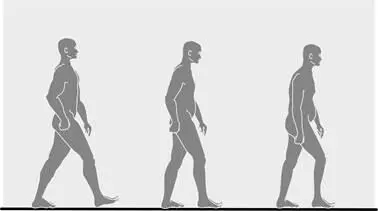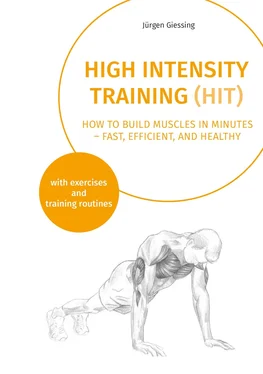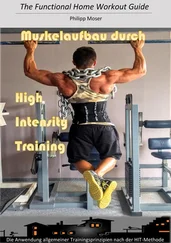The consequences of these changed living conditions are obvious. Unless we provide for it ourselves, we are tremendously lacking physical activity and, even worse, we lack resistance. Our muscles atrophy when there is no need for them to contract against an appropriate resistance. And this is a rational thing for the body to do. Why waste a lot of energy on maintaining resources like muscles when they are not needed?

Figure 1: Lack of physical exercise causes negative adaptation and regression
In our modern world we are deprived of two things we desperately need in order to be healthy: physical activity in general and intense muscular contractions in particular. And we must clearly understand that the two are not the same: There is a difference between low-intensity aerobic activities like walking or jogging and intense anaerobic work like resistance training. Physically, our body benefits from both kinds of activity.
By simply increasing the amount of physical activity, like walking and running, we can improve our general well-being but it will not do much in terms of keeping our muscles from atrophying and keeping our bones dense. The solution to this problem is very simple. We have to do both. What we need is physical activity on a regular, preferably daily basis and regular workouts with a proper degree of intensity to stimulate muscle growth or at least keep our muscles from atrophying.
The World Health Organization recommends walking at least 10,000 steps per day for maintaining or improving health. It needs to be said that even though this is a reasonable rule of thumb, this number was chosen arbitrarily. Today, most people walk 5,000 and 6,000 steps per day on average whereas just a century ago our ancestors were likely to walk between 10,000 and 20,000 steps on an ordinary working day (which was basically every day).
Increasing our daily walking range is very simple. All we need to do is take the stairs instead of the elevator, park our car further from the office entrance, or leave the car in the garage when our destination is within walking distance. It is well documented that even small increases in physical activity will have a positive effect on health. And generally speaking: the more physical activity, the better.
However, and this needs to be pointed out very clearly, this “the more, the better” approach cannot be applied to muscle training. However widespread this misconception may be, modern science has proven repeatedly that training stimuli need to be specific in terms of intensity, volume, duration, and frequency. To be effective, training has to be prescribed like medicine.
The more, the better?
The concept of “the more, the better” may be true for some things but it is definitely not a universal principle. This means that whereas it is beneficial to be physically active every day and get our 10,000 steps daily, working out every day is not necessary and may even be counterproductive.
Training volume, i.e. the quantity of training, is just one aspect of a complex process that consists of at least four interdependent factors: intensity, volume, duration, and frequency.
There is a prevalent but inappropriate overemphasize on the quantity of training (volume, duration and frequency) whereas the importance of quality of training (intensity) is often underestimated.
Volume, duration and frequency are thought to be the crucial factors for best training results because it seems to be logical that the more you train, the better results you will get out of your training. But that is not the case. There is no proportional correlation at all between the time spent training and the extent of physical improvement.
This misconception arises when transferring facts from one context to another. But working out is not the same as working even though both terms contain the same verb. In fact, working out is completely different from working in many ways. If someone has a job and is paid a certain amount of money per hour, then there is a proportional correlation between the time spent working and the amount of money earned. The more you work, the more money you get. Therefore, it may seem natural to suggest applying the same approach to working out.
Falsely assuming that there is a proportional correlation between training volume and training results, however, is to miss the whole point of training.
Intensity, rather than volume, is the crucial factor that decides whether a successful training stimulus can be achieved. If training is not intense enough, there will not be any need for the body to adapt. This is a well-known fact that is often overlooked.
Too much volume may compromise intensity and thereby compromise the effect of the training session altogether. Intensity and volume are inversely proportional. Training can either be intense or long, for example running can either be a long-distance run or a sprint but not both. There is no such thing as a sprint marathon. The same applies to resistance training. The more intensely you work out, the sooner you will fatigue. You can either train intensely or you can train long.
Therefore, training programs should be planned by determining adequate training intensity first, that is a degree of training intensity to surely pass the training threshold. Then all other factors should be adjusted accordingly.
Many people still believe that there is a proportional correlation between training quantity and training results, although they are not likely to not get better results the more they work out. Many people spend hours upon hours in the gym every week, yet they are disappointed with their progress. So why do they not question the concept of “the more the better”? This is no surprise considering what psychologists call effort justification .
Effort justification
Whenever we realize that the results we get out of something clearly do not match the amount of work we put into it, we find ourselves in a state called cognitive dissonance . In order to relieve ourselves from that unpleasant condition we tend to justify the effort and try to convince ourselves that “it is/was all worth it”. This is one reason why things that we have worked a lot on are more valuable to us. Someone who buys an old-timer and spends hundreds of hours working on it is unlikely to sell it a few years later, even if offered much more money than the purchase price.
If you went to dozens of garage sales until you found that out-of-print book which you had been looking for so long, how likely are you to sell it later? If someone studies at a University for years to pass the final exam and get the degree, it will be extremely valuable to that person, even if he or she chooses a completely different career option later for which the degree would not have been necessary.
The Sistine Ceiling paintings by Michelangelo are among the world’s most famous and most admired pieces of art. The fact that it took Michelangelo from 1508 to 1512 to finish his paintings illustrates what an effort it took to create such an outstanding piece of art. It makes us appreciate it even more.
Art is only one example where effort justification can be found. There are many others. Even architecture is one of them. The pyramids of Giza are a wonderful example of this. Although there are many higher and larger buildings today, the pyramids of Giza remain to be outstanding and rightfully remain one the Seven World Wonders. After all, it took presumably 20 years of incredibly hard work to build them and they remained the tallest man-made structures in the world for more than 3,800 years. It is very unlikely that four thousand years from now the same will be said about some of the buildings from the 20 thcentury.
Читать дальше













